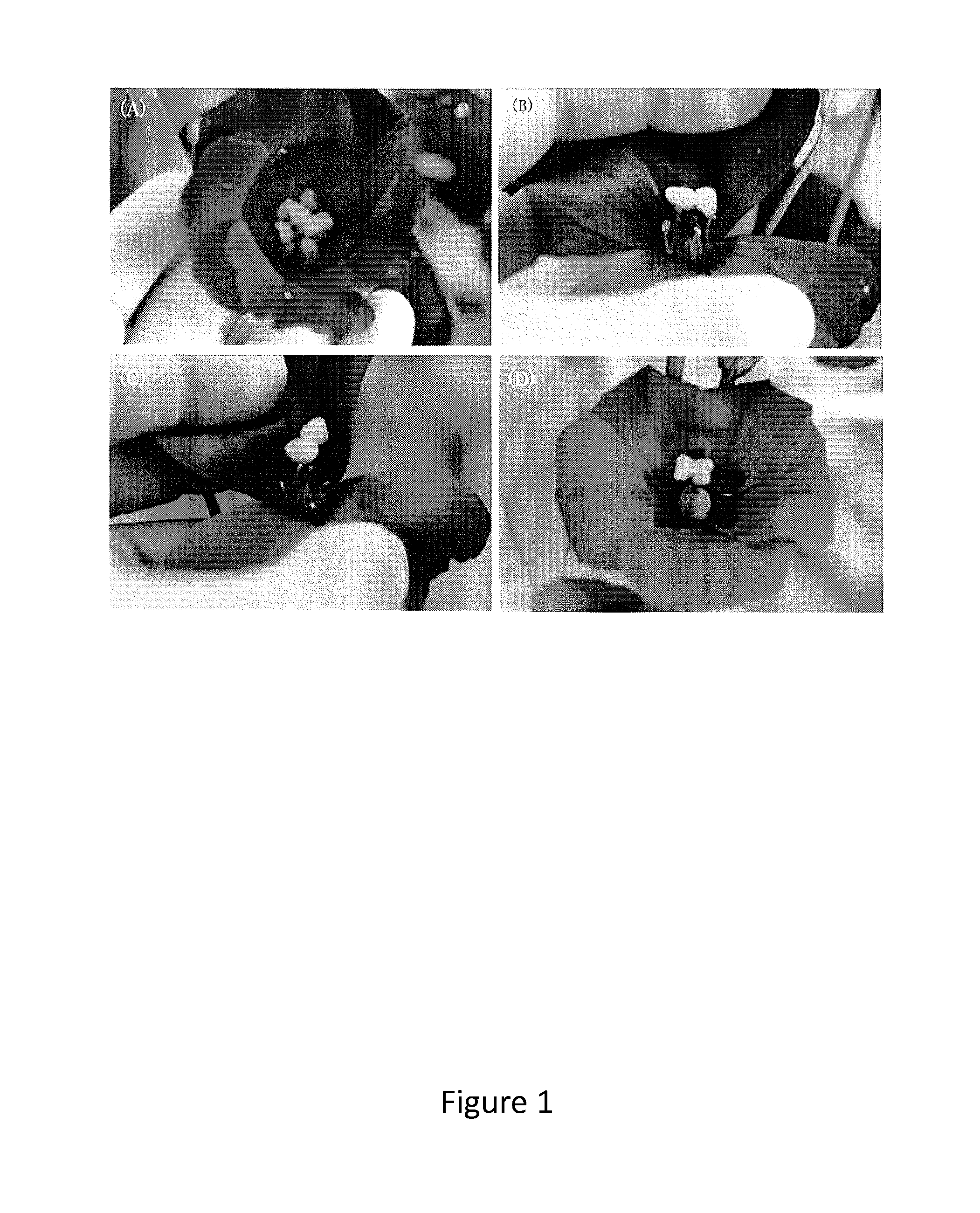Cytoplasmic male sterile eustoma and a method for developing thereof
a cytoplasmic male and eustoma technology, applied in biochemistry apparatus and processes, peptide sources, horticulture, etc., can solve the problems of unfavorable reduction in the quality of seeds, unpredictability of the emasculation period, and emergence of unintended self-pollinated seeds, etc., to achieve excellent seed productivity, flower shelf life and/or ornamental characteristics, and high-quality seeds
- Summary
- Abstract
- Description
- Claims
- Application Information
AI Technical Summary
Benefits of technology
Problems solved by technology
Method used
Image
Examples
example 1
Production of Novel Eustoma Plant Having Male Sterility
[0087]The Eustoma having male sterility of the present invention was produced at the Misato Research Station of Sakata Seed Corporation by screening from hybrids between a native Eustoma plant of unidentified species name introduced from the United States of America and Eustoma grandiflorum.
Breeding Process of Eustoma Plant According to the Present Invention
[0088]Approximately 60 sets in total of hybrids were previously prepared between dozen lines of native Eustoma plants of unidentified species name retained by Sakata Seed Corporation and parent lines (E. grandiflorum) of different origins also retained by Sakata Seed Corporation to obtain F1 seeds. These F1 seeds were sown, and the phenotypes of the F1 plants were checked. Then the F1 populations were screened for two or three appropriate individuals, which were then subjected to mass crossing to obtain progeny (hereinafter, referred to “F2 generation”) seeds.
[0089]The F2 ge...
example 2
Validation of Reproducibility of Male Sterility
[0093]In order to confirm the stable emergence of the male sterile character, the Eustoma plant E-1 was crossed as a female parent with the parent line G-10 (E. grandiflorum) as a male parent to produce F1 seeds (hereinafter, referred to as Set F). The seeds of Sets A and F were sown, and 6 individuals per set were selected and subjected to mass crossing. As a result, the individuals derived from Set A produced F2-generation seeds at a yield of 0.22 g for 56 pods, while the individuals derived from Set F produced F2-generation seeds at a yield of 0.47 g for 59 pods. The F2-generation seeds of each set were sown and examined for the rate of emergence of male sterile individuals. As a result, 19 out of 92 F2-generation individuals derived from Set A and 14 out of 88 F2-generation individuals derived from Set F exhibited the male sterile character.
[0094]These results showed that the male sterile character emerges stably.
example 3
Flower Shelf Life Test on Eustoma Variety Having Male Sterility
[0095]Male sterile lines and fertile lines were subjected to a flower shelf life test.
(1) Test Materials
[0096]Two types of Eustoma plants were used as test materials: F1 individuals of normal male fertile Eustoma and F1 individuals of cytoplasmic male sterile Eustoma. The flowers (which all appeared to have started flowering) of these two types of Eustoma individuals were collected from a Eustoma cultivation field with their peduncles on. The peduncles were adjusted to a length of 4 cm. The stigmas of the male fertile Eustoma individuals were hand-pollinated with pollen on the assumption that these individuals would be transported. Also, the cytoplasmic male sterile Eustoma individuals were or were not hand-pollinated with the pollen of a male fertile line, and these individuals were both subjected to the test.
(2) Test Method
[0097]The flower shelf life test was conducted with each test material put into a test tube fille...
PUM
| Property | Measurement | Unit |
|---|---|---|
| length | aaaaa | aaaaa |
| temperature | aaaaa | aaaaa |
| humidity | aaaaa | aaaaa |
Abstract
Description
Claims
Application Information
 Login to View More
Login to View More - R&D
- Intellectual Property
- Life Sciences
- Materials
- Tech Scout
- Unparalleled Data Quality
- Higher Quality Content
- 60% Fewer Hallucinations
Browse by: Latest US Patents, China's latest patents, Technical Efficacy Thesaurus, Application Domain, Technology Topic, Popular Technical Reports.
© 2025 PatSnap. All rights reserved.Legal|Privacy policy|Modern Slavery Act Transparency Statement|Sitemap|About US| Contact US: help@patsnap.com



